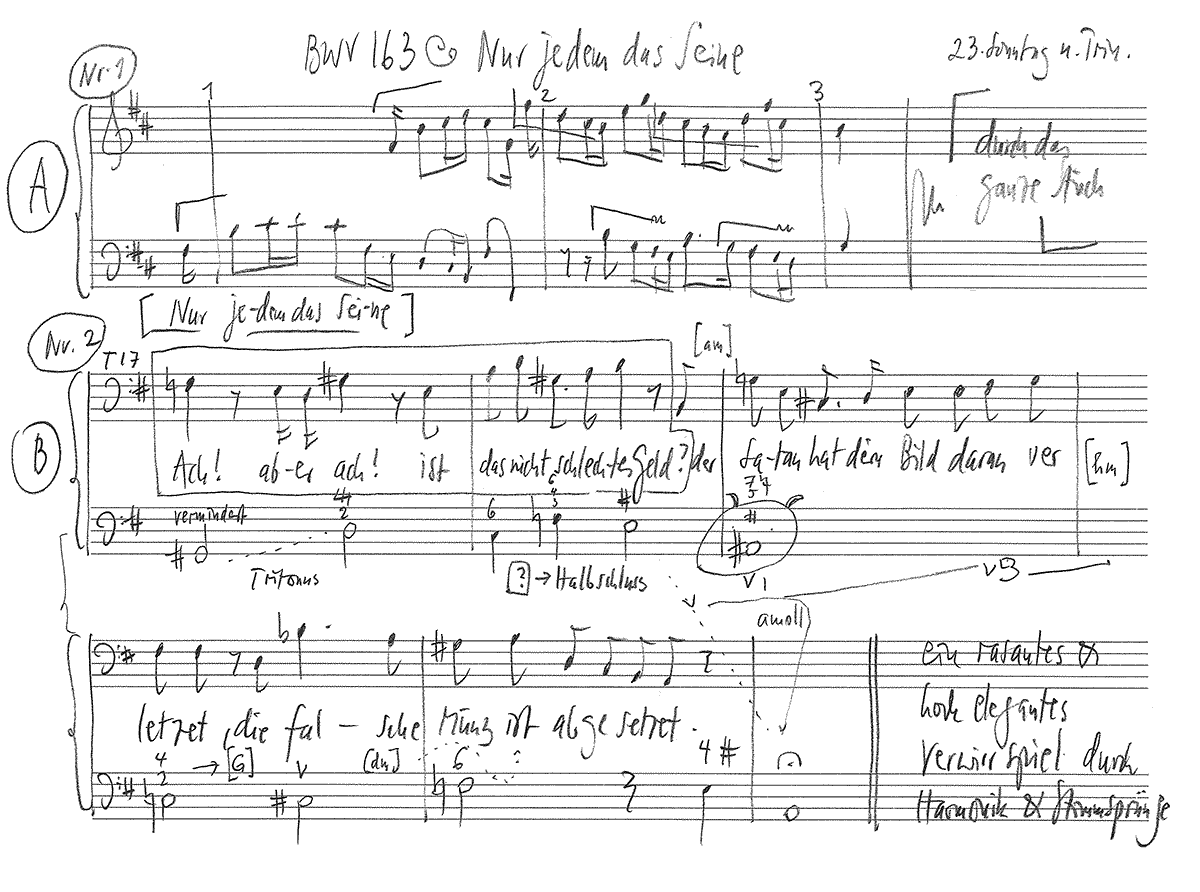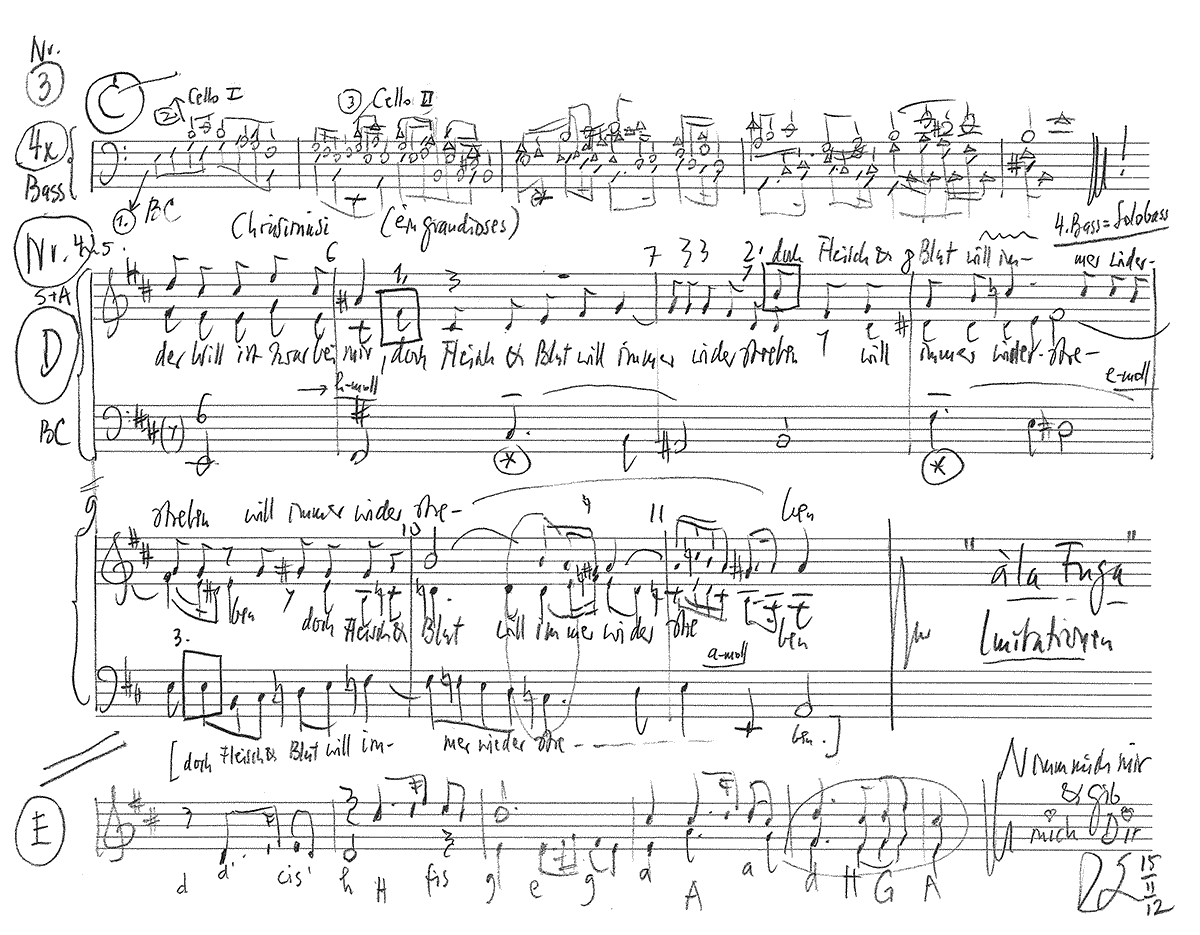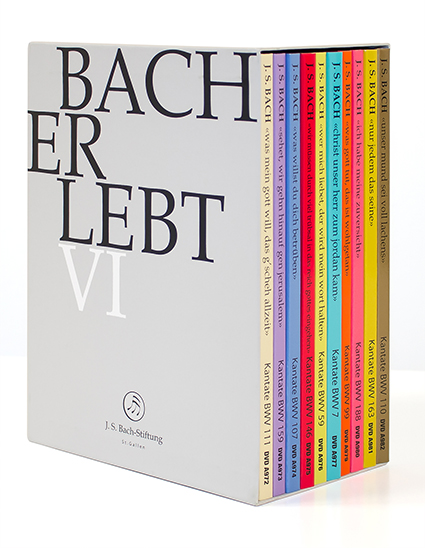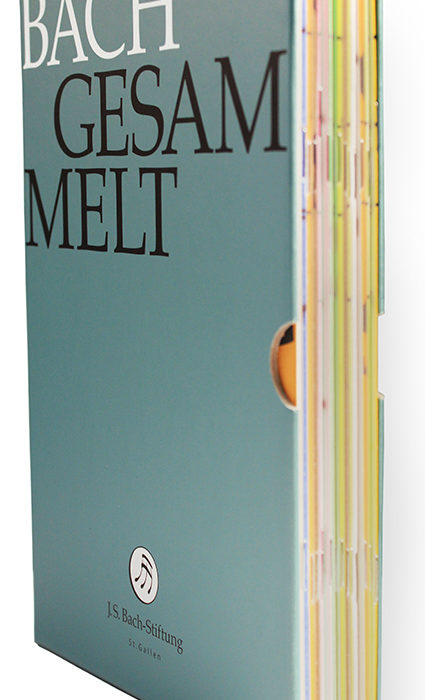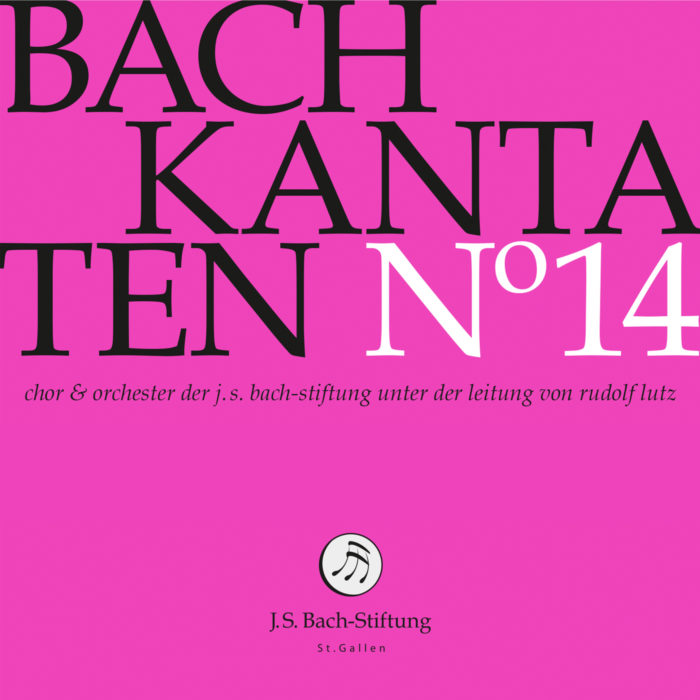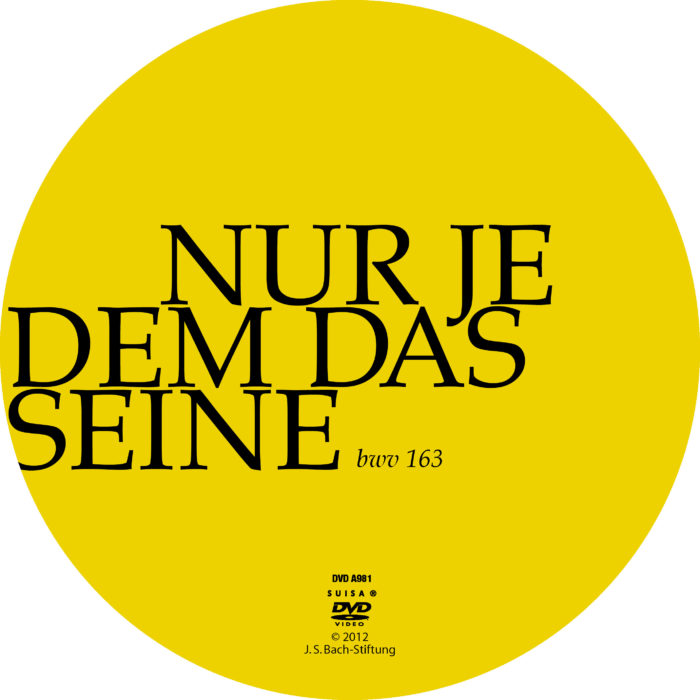Nur jedem das Seine
BWV 163 // For the Twenty-third Sunday after Trinity
(To each but what’s due him!) for soprano, alto, tenor and bass, violine I+II, viola, violoncello I+II, basso continuo
The cantata “Nur jedem das Seine!” (To each but what’s due him!) BWV 163 forms something of a chamber-music pendant to the festive cantata BWV 119. This is not necessarily because it was composed in Weimar in 1715; rather, it is mainly because of the work’s reversed perspective: in Salomo Franck’s libretto, earthly authorities are not presented as wise rulers, but as an incorrigible vice, that must be accepted in a world filled with invoices and accounts. As such, the biblical reference to “rendering unto Caesar” is interpreted here in the light of Lutheran two kingdoms doctrine: the “heart” is reserved for the “Almighty”, and the claims of state and sovereign are therefore confronted with a clear boundary at the realm of inner (religious) freedom.
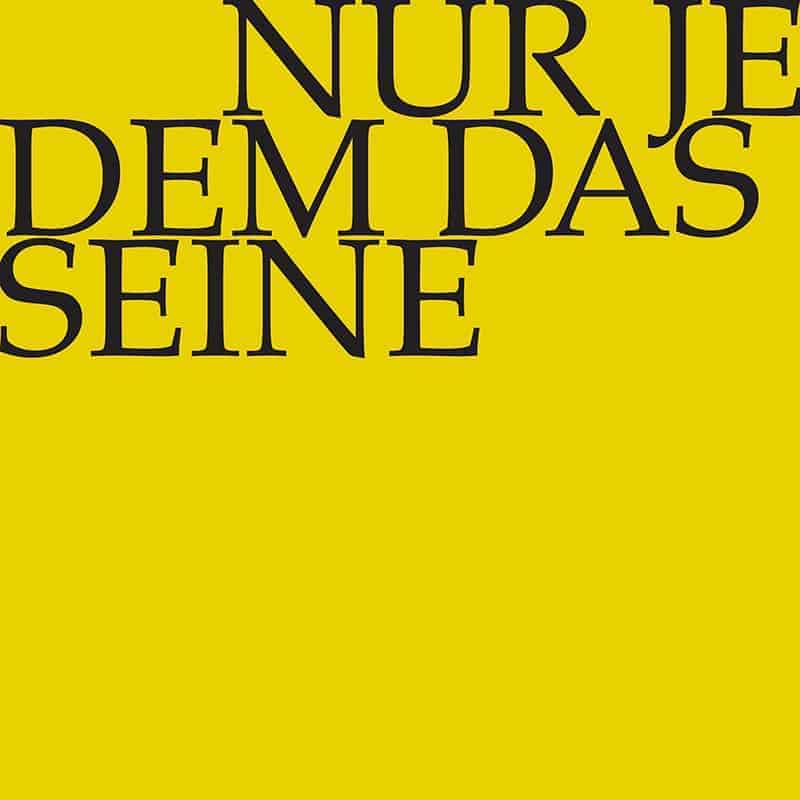
Would you like to enjoy our videos ad-free? Subscribe to YouTube Premium now...
Workshop
Reflective lecture
Soloists
Soprano
Miriam Feuersinger
Alto
Markus Forster
Tenor
Johannes Kaleschke
Bass
Markus Volpert
Orchestra
Conductor
Rudolf Lutz
Violin
Renate Steinmann, Dorothee Mühleisen
Viola
Susanna Hefti
Violoncello
Maya Amrein, Käthi Gohl Moser
Violone
Iris Finkbeiner
Organ
Nicola Cumer
Musical director & conductor
Rudolf Lutz
Workshop
Participants
Karl Graf, Rudolf Lutz
Reflective lecture
Speaker
Roland Moser
Recording & editing
Recording date
11/16/2012
Recording location
Trogen
Sound engineer
Stefan Ritzenthaler
Director
Meinrad Keel
Production manager
Johannes Widmer
Production
GALLUS MEDIA AG, Switzerland
Producer
J.S. Bach Foundation of St. Gallen, Switzerland
Librettist
Text
Salomo Franck (1659–1725)
Text No. 6
Johann Heermann (1585–1647)
First performance
Twenty-third Sunday after Trinity,
24 November 1715
In-depth analysis
Accordingly, the mellifluous introductory aria is extremely economic in its conception. The concise motto “Nur jedem das Seine” permeates the string movement throughout, gradually engendering a sense of joyless obligation with its perpetual repetition.
The bass recitative then musically interprets the poet’s line of argument. From words of humble praise to the creator, Franck deduces that all earthly wealth is given by God and is therefore only borrowed. When he then describes the inconstant heart as a counterfeit that has lost all value – a false coin to be written off – he effectively compares the annual collection of expired coins (which both removed counterfeits from circulation and served as a hidden tax) to the process of introspection and soul-searching. Here, the bitter and dogged music underscores that the “coin” of the heart, too, can be false if it has a satanic idol stamped on it.
The metaphors of minting coins and circulating money are explored further in the bass aria. Scored for voice and two obbligato celli – a unicum in Bach’s cantata oeuvre – the entire movement is set in a low register. Over a busy bass line, the industrious celli offer a musically picturesque vision of “melting” and “stamping” coins, while the low register reflects the deep, internal nature of this process in the “mine” of the soul.
The following recitative is equally novel in approach. Set as a duet for soprano and alto in canonic style, it reveals a dramatic quality reminiscent of the early German operas of Stölzel and Keiser. The brief coda blends so smoothly into the ensuing aria duet that it would be fair to view the setting as a doublemovement. The exchange of short motives evokes a sense of great closeness throughout, calling to mind a love duet or a sacred French “petit motet”, albeit one with a German-Lutheran touch thanks to the integration of the chorale melody “Meinen Jesum laß ich nicht”.
Bach’s instructions on the sole surviving score of the closing movement are short and precise: “Choral. Simplice stylo”. Since only the basso continuo is notated, the upper parts must be reconstructed in performance and publications. This chorale concludes a cantata in which poet and composer each present an unconventional, yet highly accessible approach to the eternal themes of personal values and binding commitments.
Libretto
1. Arie (Tenor)
Nur jedem das Seine!
Muß Obrigkeit haben
Zoll, Steuern und Gaben,
man weigre sich nicht
der schuldigen Pflicht!
Doch bleibet das Herze dem Höchsten alleine.
2. Rezitativ (Bass)
Du bist, mein Gott, der Geber aller Gaben;
wir haben, was wir haben,
allein von deiner Hand.
Du, du hast uns gegeben
Geist, Seele, Leib und Leben
und Hab und Gut und Ehr und Stand!
Was sollen wir denn dir
zur Dankbarkeit dafür erlegen,
da unser ganz Vermögen
nur dein und gar nicht unser ist?
Doch ist noch eins, das dir, Gott, wohlgefällt:
Das Herze soll allein,
Herr, deine Zinsemünze sein.
Ach! aber ach! ist das nicht schlechtes Geld?
Der Satan hat dein Bild daran verletzet,
die falsche Münz ist abgesetzet.
3. Arie (Bass)
Laß mein Herz die Münze sein,
die ich dir, mein Jesu, steure!
Ist sie gleich nicht allzu rein,
ach, so komm doch und erneure,
Herr, den schönen Glanz bei ihr!
Komm, arbeite, schmelz und präge,
daß dein Ebenbild bei mir
ganz erneuert glänzen möge!
4. Rezitativ (Duett Sopran, Alt)
Ich wollte dir,
o Gott, das Herze gerne geben;
der Will ist zwar bei mir,
doch Fleisch und Blut will immer widerstreben.
Dieweil die Welt
das Herz gefangen hält,
so will sie sich den Raub nicht nehmen lassen;
jedoch ich muß sie hassen,
wenn ich dich lieben soll.
So mache doch mein Herz
mit deiner Gnade voll;
leer es ganz aus von Welt und allen Lüsten,
und mache mich zu einem rechten Christen.
5. Arie (Duett Sopran, Alt)
Nimm mich mir und gib mich dir!
Nimm mich mir und meinem Willen,
deinen Willen zu erfüllen;
gib dich mir mit deiner Güte,
daß mein Herz und mein Gemüte
in dir bleibe für und für,
nimm mich mir und gib mich dir!
6. Choral
Führ auch mein Herz und Sinn
durch deinen Geist dahin,
daß ich mög alles meiden,
was mich und dich kann scheiden,
und ich an deinem Leibe
ein Gliedmaß ewig bleibe.



